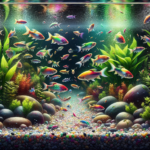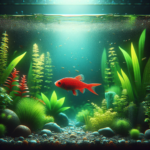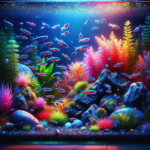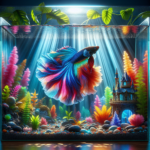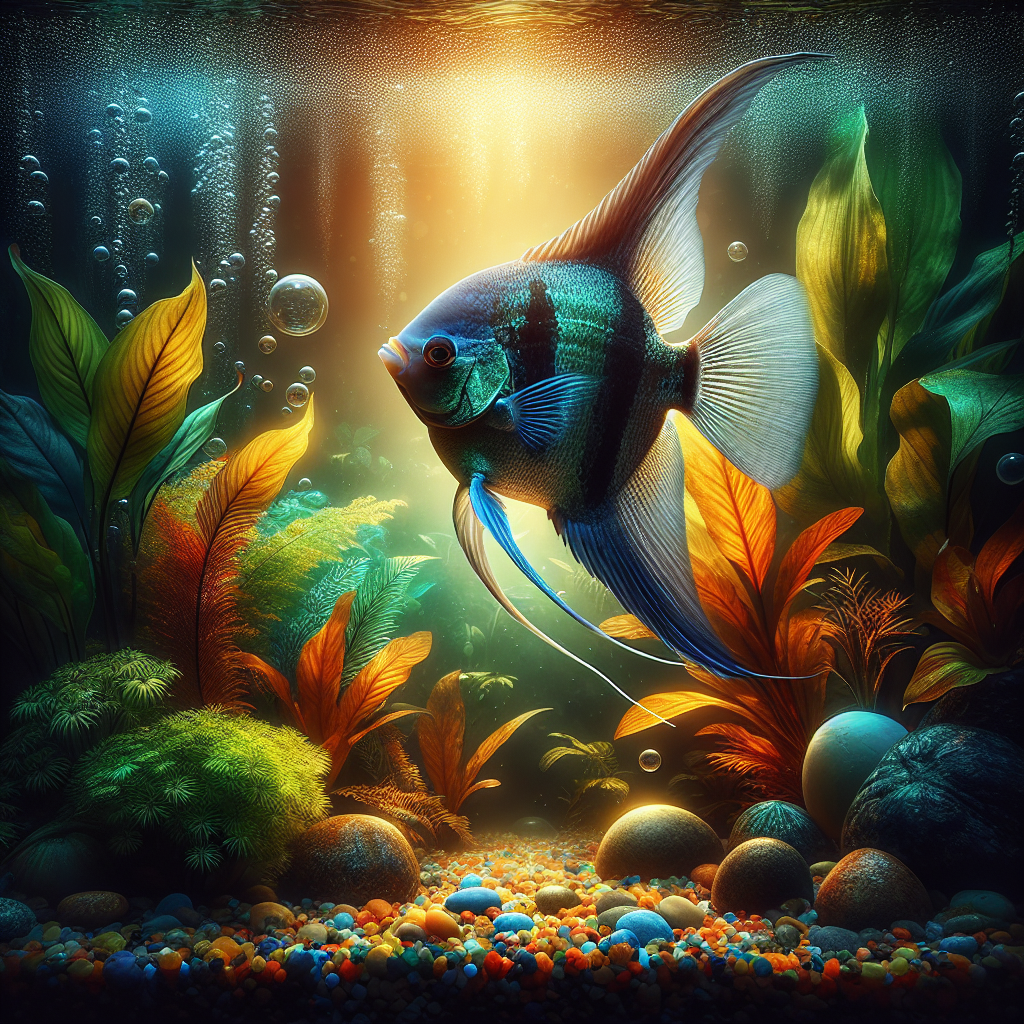
Creating a custom aquarium for angelfish is an exciting journey into aquatic design and husbandry. Whether you’re a seasoned aquarist or a curious newcomer, understanding the essentials of angelfish care and tank setup is key to building a thriving underwater sanctuary. Let’s dive into the intricacies of size, cost, and design options for your angelfish custom aquarium.
Key Takeaways
-
Angelfish require a minimum tank size of 20 gallons, with larger spaces preferred for groups.
-
Initial setup costs for a custom angelfish aquarium can range from $400 to over $1500, depending on size and features.
-
Vertical tank space is crucial for angelfish, given their tall body shape and swimming style.
-
Implementing a combination of live plants, rocks, and driftwood can create an ideal habitat for angelfish.
-
Companion selection is important; angelfish thrive with peaceful, similarly-sized tank mates.
Choosing the Right Size Aquarium for Your Angelfish
When it comes to housing angelfish, size does matter. These elegant swimmers are not only visually striking but also active and territorial. A cramped tank can lead to stress, which in turn can cause health issues. Therefore, selecting the right aquarium size is the first step to ensuring your angelfish lead happy, healthy lives.
Understanding Angelfish Space Requirements
Angelfish hail from the Amazon Basin and are accustomed to roomy environments. In captivity, a single angelfish should have at least a 20-gallon tank. However, if you plan to keep a pair or a small group, you’ll need to size up considerably. A general rule is to add an additional 10 gallons for each new angelfish to prevent overcrowding and to provide ample swimming space.
Size Options: From Nano Tanks to Large Showpieces
While nano tanks can be charming and space-efficient, they’re not suited for angelfish, which can grow up to 6 inches in height. Instead, consider medium to large tanks that not only accommodate their size but also their need for vertical space. A tall tank design is preferable because it mimics the angelfish’s natural habitat, where they often swim among tall plants and roots.
Cost Considerations for Building Your Dream Tank
Building a custom aquarium for your angelfish is an investment. Costs can vary widely based on size, materials, and the level of customization you desire. Let’s look at what you can expect to invest in your aquatic masterpiece.
For a standard 20-gallon setup, you might spend around $400, while larger, more elaborate setups can easily surpass $1500.
Breaking Down the Budget: Expenses to Expect
Here’s a breakdown of the typical costs associated with setting up a custom angelfish aquarium:
-
Tank: Depending on size and quality, tanks can cost anywhere from $50 to several hundred dollars.
-
Stand: A sturdy stand is a must-have, and prices range from $30 to $300+.
-
Filtration system: Essential for clean water and angelfish health, filters run from $20 to $150.
-
Lighting: Proper lighting not only showcases your angelfish but also supports plant growth, costing $20 to $200.
-
Heater: To maintain the tropical temperatures angelfish require, expect to pay $15 to $50 for a quality heater.
-
Substrate and decorations: Gravel, plants, and ornaments can add up to $100 or more to your total.
Saving Tips: Where Quality Meets Affordability
While you shouldn’t cut corners on essential items like filtration and heating, there are ways to save without sacrificing quality. Opt for a simpler tank design and gradually add decorations over time. Choose hardy live plants that serve both as decor and as a natural filtration aid. Also, keep an eye out for deals at your local fish store or online retailers.
Remember, the wellbeing of your angelfish is paramount. Investing in a well-thought-out custom aquarium will pay dividends in the form of vibrant fish and a captivating display that brings a piece of the tropics into your home.
Water Parameters: The Key to a Thriving Environment
Just like us, angelfish need the right living conditions to thrive. The water in your tank should mimic their natural Amazonian habitat. This means maintaining a slightly acidic pH level between 6.8 and 7.8, water hardness between 3° and 8° dKH (54 to 145 ppm), and a temperature range of 76°F to 84°F. It’s vital to use a reliable water testing kit to keep track of these parameters.
Decor and Plant Life: Building a Natural Angelfish Paradise
Angelfish love to explore and need places to hide and feel secure. To create a habitat that’s both functional and beautiful, consider the following:
-
Live plants: Species like Amazon Sword and Java Fern not only look great but also help maintain water quality.
-
Driftwood: It offers a natural look and can help to soften the water.
-
Rocks and caves: These provide hiding spots and help angelfish feel safe.
Arrange these elements in a way that allows open swimming space while also offering secluded areas for your angelfish to retreat to.
Companion Selection: Angelfish-Friendly Tank Mates
Finding the right tank mates for your angelfish is crucial for a peaceful aquarium. Because angelfish can be territorial, especially during breeding, they do best with non-aggressive fish of a similar size.
Good companion choices include larger tetras, peaceful barbs, and dwarf cichlids. Avoid fin-nippers like some barbs and smaller, more energetic fish that could stress out your angelfish.
Choosing Companions Wisely: Who Gets Along with Angelfish?
When selecting tank mates, consider the temperament and swimming levels of potential companions. For instance:
-
Bottom dwellers: Corydoras catfish are excellent because they stay out of the angelfish’s way.
-
Mid-water swimmers: Peaceful fish like Mollies and Platies can coexist nicely.
Avoid overly aggressive fish or those small enough to be considered prey. It’s all about balance and ensuring each species has its own space.
Tips for Creating a Harmonious Community Aquarium
Introduce new tank mates to the aquarium at the same time as your angelfish, if possible. This prevents established territories and reduces aggression. Provide plenty of hiding spots and visual barriers with plants and decor to diffuse tension.
Seamless Maintenance for a Pristine Angelfish Kingdom
Regular maintenance is the key to a healthy angelfish aquarium. A consistent routine helps prevent algae growth, keeps water parameters stable, and ensures your fish are happy and healthy.
-
Perform weekly water changes of about 25% to remove waste and replenish minerals.
-
Clean the substrate with a gravel vacuum to prevent ammonia and nitrate build-up.
-
Check your filter monthly and clean or replace media as needed to keep it running efficiently.
Sticking to a schedule will make maintenance less daunting and more manageable.
Routine Cleaning: Keeping Your Aquatic Vista Clear
Clarity is both aesthetically pleasing and indicative of water quality. To maintain a crystal-clear view:
-
Use a magnetic algae scraper for the front glass, being careful around the silicone edges.
-
Trim and prune live plants regularly to prevent decay and excess nutrients.
-
Consider a tank-cleaning crew, like snails or certain shrimp, that can help control algae and detritus.
Feeding Your Angelfish: Nutritional Needs and Treats
Angelfish are omnivores with a lean towards carnivorous habits. A balanced diet includes:
-
High-quality flakes or pellets as a staple.
-
Frozen or live foods like bloodworms or brine shrimp for protein.
-
Vegetable supplements to ensure a well-rounded diet.
Feed your angelfish small amounts two to three times a day, and only as much as they can consume in about 30 seconds to avoid overfeeding and water quality issues.
As we round out our exploration of angelfish custom aquariums, it’s important to recognize that the beauty of these aquatic pets is matched by their unique care requirements. The final touches to your angelfish habitat are crucial to their well-being and the overall harmony of your aquatic community.
Dive Into the World of Angelfish Custom Aquariums
Why Angelfish Make Marvelous Aquarium Pets
Angelfish are a stunning addition to any home aquarium. Their majestic fins and diverse color patterns make them a focal point in a well-planned tank. Moreover, their serene demeanor and graceful swimming can bring a sense of calm to any observer. Angelfish are also intelligent and can recognize their caregivers, often greeting them with an eager display at feeding time.
The Balance Between Beauty and Budget
While angelfish can elevate the aesthetics of your home, it’s essential to balance the desire for a beautiful display with the practicality of your budget. Prioritize the health and comfort of your angelfish by investing in a proper-sized tank and efficient equipment. You can always enhance your setup over time as resources allow.
FAQs: All About Angelfish and Custom Aquariums
-
How often should you feed angelfish?
-
Can angelfish live with other species?
-
What is the ideal temperature for an angelfish tank?
-
How to maintain angelfish health in a custom aquarium?
-
What is the perfect aquarium size for a growing angelfish?
How Often Should I Feed My Angelfish?
Feeding your angelfish two to three times a day in small amounts is ideal. This frequency ensures they receive the nutrients they need without overfeeding, which can pollute the water. Observe your fish during feeding to ensure they are eating well and to monitor their health.
Can Angelfish Live with Other Species in the Same Tank?
Yes, angelfish can live with other peaceful fish of similar size. Good companions include larger tetras, gouramis, and certain dwarf cichlids. However, avoid housing them with aggressive species or fin-nippers that could cause stress or injury to your angelfish.
What is the Ideal Temperature for an Angelfish Tank?
The optimal temperature range for an angelfish tank is between 76°F and 84°F. Consistency is key, as fluctuations can stress your fish. Use a reliable aquarium heater and regularly check the temperature to ensure a stable environment.
How to Keep an Angelfish Healthy in a Custom Aquarium?
To keep your angelfish healthy, maintain clean water conditions, provide a balanced diet, and ensure the tank is adequately sized with plenty of hiding places. Regular monitoring of water parameters and prompt attention to any health issues are also essential.
What Size of Custom Aquarium is Perfect for a Growing Angelfish?
For a single angelfish, a 20-gallon tank is the minimum size. However, if you plan to keep multiple angelfish or want them to have ample space to grow and thrive, consider a larger tank, adding an extra 10 gallons for each additional angelfish. A tank with vertical space is also crucial due to their body shape.
In conclusion, creating a custom aquarium for angelfish is a rewarding endeavor that combines the art of aquatic design with the science of fish care. By focusing on the size, cost, and design options tailored to angelfish, you can ensure a healthy and beautiful environment for these elegant creatures. With the right knowledge and resources, your angelfish custom aquarium will be a source of endless fascination and joy.
